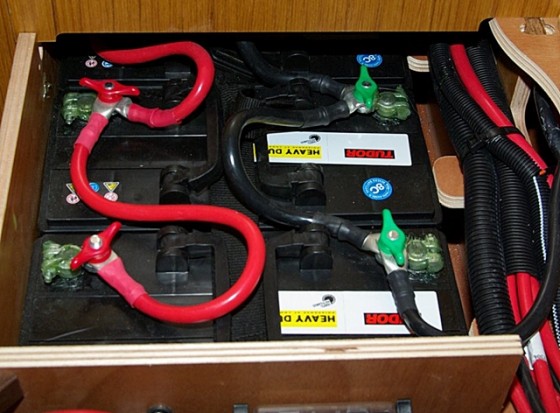No Grease on Marine Battery Terminals!
Grease, not to mention petroleum jelly, will liquefy in the heat and eventually form an insulating barrier that will cause a loss of electrical power.
May 30, 2013
Question: The photo I sent in shows the battery installation on my boat. The green stuff on the battery terminals is a waterproof grease that I have always used on my battery terminals to help reduce any corrosion build-up. I was showing this installation off to a friend of mine and he says that the grease is a really bad idea. What’s up with this? I’ve been doing this for years on my cars and really haven’t had any problems.

The green grease on these terminals will melt in the heat and cause problems down the road. Also, wing nuts are no longer ABYC-compliant in this application.
Answer: I’m definitely on your friend’s side on this one, and I’m someone who used white lithium-based grease on battery terminals for years. The problem here is that, depending upon the grease itself and its actual melting point, you can create a situation where the grease will liquefy and act like a penetrating oil. It won’t take much heat. For example, Vaseline petroleum jelly, which many people use for this purpose, has a melting point just slightly higher than normal body temperature of 98.6 deg. F. On a hot summer day, the temperature surrounding your batteries will reach that temperature quite easily. The white lithium on the other hand has a melting point of about 360 deg. F -- which is still achievable on a hot summer day while pulling a heavy electrical load through the terminal.
The next phase of the problem is that the liquefied grease will penetrate down between the battery post and the inside of the terminal clamp. As the grease (now a liquid) continues to heat up between the post and the clamp, it will eventually oxidize and turn into a rather good insulator, the last thing you want at a battery post! The nasty part of all of this is that it is totally invisible, so there won’t be any visual clue like corrosion that any problem exists. If this problem goes unnoticed for a while, you will eventually lose electrical power, obviously a problem.
I should also point out that in the photo you sent us, wing nuts (ever-popular) are used to hold the battery lugs in place. Due to their tendency to come loose, these are no longer compliant with ABYC standards that apply to battery lugs. The new standard (E-10) states that wing nuts can only be used on cables sized 8 SWG or smaller. The wing nuts on your battery cable connections should be replaced with hex nuts and lock washers.












